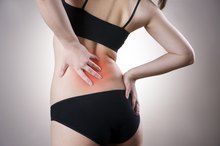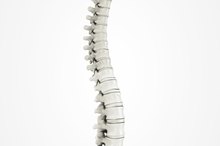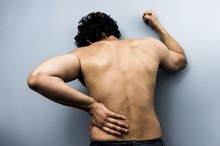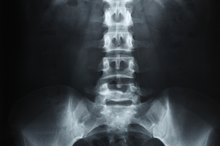A Diet for a Bulging Disc
A bulging disk refers to a protrusion in the soft pad that separates the vertebrae in your spine. The term is often used interchangeably with other disk problems, such as a slipped or ruptured disk, though the conditions aren’t the same. Thought to be part of the natural aging process, bulging disks are quite common and don’t usually lead to any symptoms. But as soon as the protrusion encroaches on a nerve, you may begin to notice some discomfort. Treatment for a bulging disk typically involves pain relievers and exercise. However, a specific diet isn’t regularly used to correct this type of back problem.
Weight Loss
While no specific diet can treat a bulging disk, it doesn’t mean dietary changes can’t help alleviate your discomfort. In fact, excess body weight can place stress on one or more of the disks in your spine, particularly in the lower back. This makes the disks more likely to bulge – or herniate, for that matter. Weight loss can, therefore, relieve some of the strain causing the disk to protrude.
- While no specific diet can treat a bulging disk, it doesn’t mean dietary changes can’t help alleviate your discomfort.
- In fact, excess body weight can place stress on one or more of the disks in your spine, particularly in the lower back.
Caloric Deficit
What Is the Difference Between a Herniated Disc & a Bulging Disc?
Learn More
It takes a deficit of 3,500 calories to lose one pound of fat. If you’re able to reduce your caloric intake enough to generate a deficit of 500 calories a day, you can expect to lose 1 lb. in a week’s time. To cut calories from your diet, start off by limiting your portion sizes. Eating less at each meal has a direct impact on your caloric intake. From there, incorporate healthier foods into your diet. Fruits, vegetables, legumes and whole grains are all relatively low in calories, which can help cut additional calories from your diet.
- It takes a deficit of 3,500 calories to lose one pound of fat.
- To cut calories from your diet, start off by limiting your portion sizes.
Supplementation
Besides losing weight, you may also see an improvement in your condition by supplementing your diet with glucosamine and chondroitin sulfate. A case study published in the June 2003 “Biomedical Center Complementary and Alternative Medicine” found that these two compounds can counteract spinal disc degeneration, especially when caught early. Therapeutic dosage was set at 500 mg of glucosamine and 400 mg of chondroitin sulfate, taken twice in the morning and then once in the evening for nine months, which was then followed with once in the morning and again in the evening for another year and three months.
Effects
What Is a Eccentric Disc Bulging?
Learn More
After six months, the patient in the case study saw an improvement in both range of motion and pain. By the end of the two years, the strength and flexibility of the back improved, as well. Talk to your doctor to determine the best course of treatment for your bulging disk. He may decide that a combination of medications, exercise and dietary changes are the best options for you, while others may see an improvement with dietary supplementation. As with any medical condition, treatment should be individualized.
- After six months, the patient in the case study saw an improvement in both range of motion and pain.
Related Articles
References
- Spine Health; What’s a Herniated Disc, Pinched Nerve, Bulging Disc?; Peter Ullrich; July 2009
- Biomedical Center Complementary and Alternative Medicine; Glucosamine and Chondroitin Sulfate Supplementation to Treat Symptomatic Disc Degeneration: Biochemical Rationale and Case Report; Wim van Blitterswijk, et al.; June 2003
Writer Bio
Based in Minneapolis, Minn., Dana Severson has been writing marketing materials for small-to-mid-sized businesses since 2005. Prior to this, Severson worked as a manager of business development for a marketing company, developing targeted marketing campaigns for Big G, Betty Crocker and Pillsbury, among others.







